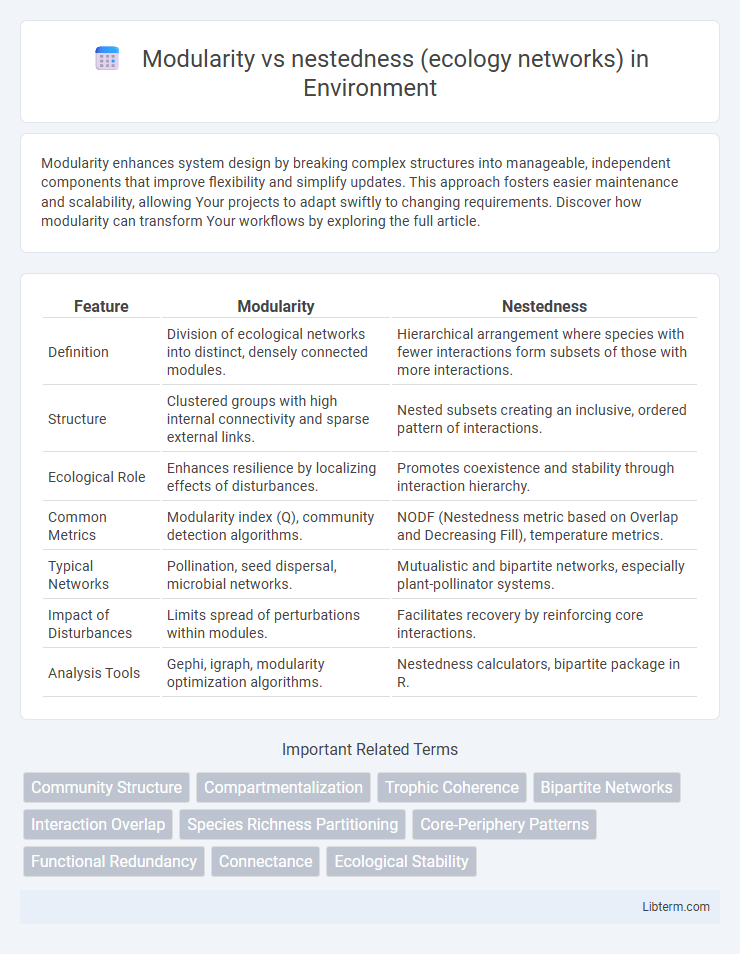Modularity enhances system design by breaking complex structures into manageable, independent components that improve flexibility and simplify updates. This approach fosters easier maintenance and scalability, allowing Your projects to adapt swiftly to changing requirements. Discover how modularity can transform Your workflows by exploring the full article.
Table of Comparison
| Feature | Modularity | Nestedness |
|---|---|---|
| Definition | Division of ecological networks into distinct, densely connected modules. | Hierarchical arrangement where species with fewer interactions form subsets of those with more interactions. |
| Structure | Clustered groups with high internal connectivity and sparse external links. | Nested subsets creating an inclusive, ordered pattern of interactions. |
| Ecological Role | Enhances resilience by localizing effects of disturbances. | Promotes coexistence and stability through interaction hierarchy. |
| Common Metrics | Modularity index (Q), community detection algorithms. | NODF (Nestedness metric based on Overlap and Decreasing Fill), temperature metrics. |
| Typical Networks | Pollination, seed dispersal, microbial networks. | Mutualistic and bipartite networks, especially plant-pollinator systems. |
| Impact of Disturbances | Limits spread of perturbations within modules. | Facilitates recovery by reinforcing core interactions. |
| Analysis Tools | Gephi, igraph, modularity optimization algorithms. | Nestedness calculators, bipartite package in R. |
Introduction to Ecological Networks
Ecological networks often exhibit distinct structural patterns such as modularity and nestedness, which influence species interactions and ecosystem stability. Modularity refers to the presence of densely connected subsets or modules within the network that interact more strongly among themselves than with other parts. Nestedness describes a hierarchical organization where interactions of specialist species form subsets of those of generalists, promoting robustness in mutualistic networks like pollination or seed dispersal systems.
Defining Modularity in Ecological Contexts
Modularity in ecological networks refers to the degree to which species interactions are compartmentalized into distinct modules or clusters with dense internal connections and sparse links between them. This structural property enhances ecosystem stability by limiting the spread of perturbations and promoting functional specialization within modules. Quantifying modularity often involves algorithms such as the Louvain or Newman methods, which detect community structure to better understand species groupings and ecological dynamics.
Understanding Nestedness in Ecosystems
Nestedness in ecological networks describes a pattern where species interactions form subsets, with specialists interacting with proper subsets of the species that generalists interact with. This structure enhances ecosystem stability by promoting resilience through redundancy and facilitating species coexistence in mutualistic networks like pollination or seed dispersal. Quantitative metrics such as NODF (Nestedness metric based on Overlap and Decreasing Fill) help assess nestedness, providing insights into community assembly processes and biodiversity maintenance.
Key Differences: Modularity vs Nestedness
Modularity in ecological networks refers to the presence of distinct groups or modules where species interactions occur more frequently within groups than between them, enhancing ecosystem stability and resistance to perturbations. Nestedness describes a pattern where species with fewer interactions form subsets of those with more interactions, often indicating hierarchical specialization and mutualistic relationships. Key differences include modularity emphasizing compartmentalization and species group segregation, while nestedness highlights interaction hierarchies and overlap among species.
Detecting Modularity in Ecological Data
Detecting modularity in ecological networks involves identifying clusters of species that interact more frequently among themselves than with others, revealing functional groupings or habitat compartments. Algorithms like the Louvain method and spectral clustering effectively partition ecological interaction matrices to uncover modular structures that influence ecosystem stability and resilience. Quantifying modularity through indices such as Newman's modularity score helps ecologists link network topology to processes like species coexistence and community organization.
Measuring Nestedness in Ecological Networks
Measuring nestedness in ecological networks involves quantifying the degree to which species interactions form subsets within more generalized patterns, commonly using metrics like NODF (Nestedness metric based on Overlap and Decreasing Fill). These metrics assess the hierarchical organization of species interactions, reflecting nested subsets that indicate stability and resilience in mutualistic networks such as plant-pollinator or host-parasite systems. Accurate nestedness measurement aids in understanding community structure, biodiversity maintenance, and ecosystem functioning across various ecological scales.
Ecological Implications of Modularity
Modularity in ecological networks enhances ecosystem stability by compartmentalizing species interactions, which limits the spread of perturbations and mitigates cascading extinctions. High modularity supports functional diversity and resilience, allowing communities to maintain ecosystem services despite environmental fluctuations. This structural property promotes coexistence and adaptive potential by enabling specialized subgroups to evolve independently within complex habitats.
Ecological Consequences of Nestedness
Nestedness in ecological networks enhances species coexistence by promoting asymmetric interactions that reduce competition and support specialist species persistence. This structural pattern increases network stability and resilience to perturbations by creating redundancy in species roles and interaction pathways. High nestedness also facilitates more efficient resource utilization, which benefits overall community productivity and ecosystem functioning.
Modularity and Nestedness: Interactions and Trade-offs
Modularity in ecological networks refers to the organization of species into distinct groups with dense interactions within modules and sparse connections between them, promoting stability and resilience against perturbations. Nestedness describes a pattern where specialist species interact with subsets of the partners of generalist species, enhancing community robustness and resource utilization efficiency. The trade-offs between modularity and nestedness influence the balance between network compartmentalization and integrative species interactions, affecting overall ecosystem functioning and vulnerability to species loss.
Future Directions in Network Structure Research
Future research in ecology networks will increasingly explore the balance between modularity and nestedness to better understand ecosystem resilience and species interactions. Advanced computational models and high-resolution data will enable more precise quantification of these network structures, revealing how changes in modularity or nestedness affect biodiversity and stability under environmental stress. Integrating multilayer network approaches and temporal dynamics promises to uncover new insights into adaptive network responses and the evolutionary drivers of ecological complexity.
Modularity Infographic

 libterm.com
libterm.com